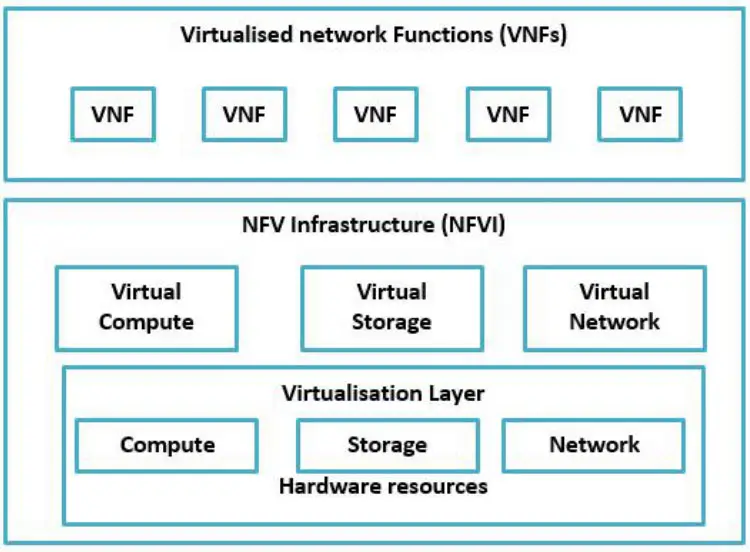NFV & SDN Testing
NFV, SDN Product Development & Testing Services for core network elements, routers,switches.
NFV, SDN Product Development & Testing Services
OdiTek’s NFV &SDN Testing CoE
We have complete set of interface and protocol expertise that can effectively be used in functional and load testing of NFV and SDN network elements. In NFV functional testing area, we can test NFV Service Metrics, QoS and Data-plane metrics,QoE and Control-plane metrics etc.
What is NFV ?
Network Functions Virtualization (NFV) is a network architecture concept that proposes using IT virtualization related technologies to virtualize entire classes of network node functions into building blocks that may be connected, or chained, together to create communication services.
NFV relies upon, but differs from traditional server virtualization techniques such as those used in enterprise IT. A VNF consist of one or more virtual machines running different software and processes, on top of industry standard high volume servers, switches and storage, or even cloud computing infrastructure, instead of having custom hardware appliances for each network function.
Transition to NFV, Cloud and SDN-based infrastructure paves a range of opportunities to innovative services. However, as network functions are moved from dedicated hardware to cloud infrastructure, an additional performance impact is introduced in network services. Hence, service providers need to assess the potential impact of SLA metrics due to transition to NFV.
NFV Framework
The NFV framework consists of three main components.
Virtualized Network Functions (VNF) are software implementations of network functions that can be deployed on a Network Function Virtualization Infrastructure (NFVI).
NFV Infrastructure (NFVI) is the totality of all hardware and software components which build up the environment in which VNFs are deployed. The NFV-Infrastructure can span across several locations. The network providing connectivity between these locations is regarded to be part of the NFV-Infrastructure.
Network Functions Virtualization Management and Orchestration Architectural Framework (NFV-MANO Architectural Framework) is the collection of all functional blocks, data repositories used by these functional blocks, and reference points and interfaces through which these functional blocks exchange information for the purpose of managing and orchestrating NFVI and VNFs.
At a Glance
OdiTek focuses on testing new technologies & technology generations. It aims to be a preferred partner for enterprises that develop software products based on Telecom Wireless, along with providing QA / Testing services (products & services).
- Focussed on Telecom Wireless, Mobile & Internet technologies.
- Expertise on telecom product development (Wireless), strong on all latest technologies in telecom wireless networks (2G, 3G, IMS, WiMAX, LTE, 5G..). We have telecom teams who are one of the first ones in India who worked on LTE & Air Interface.
- Deployment, testing of telecom network equivalents and solutions
Focus on implementation, support, development, upgrade, rollouts & QA services for Telecoms - OdiTek brings in a very strong competency pool and experienced professional expertise that makes project commitments more reliable and consistent.
- Proven offshore delivery model to provide competitive edge.
Key Service Offerings
- Product Development on C, C++, Java
- Field deployment & testing of Telecom Equipments
- Proprietary scripting for baseline releases
- Applications for all technology generations- 5G (RAN, EPC, Air).
- Telecom Wireless Consulting
- E2E QA solution for 5G, EPC Regression, Load Testing
- Expertise on various simulators like EXFO EAST, IxLoad, dsTest scripts
to test against real/simulated SUT/DUT - Bug tracking; test plans & execution
- Sanity & regression tests of new packages/baselines
Key NFV & SDN Specialities
- NFV Service Metrics,
- QoS and Data-plane metrics,
- QoE and Control-plane metrics
- Scalability
- Performance Testing
- Failover Convergence Testing
- EPC Nodes and Network elements testing
- Policy and Charging Control Testing;
- Usage Reporting and Monitoring

Telecom Testing

Contract Programming

Offshore Teaming
NFV Test Architecture

QoE and Control-plane metrics
Direct metrics:
Peak Signal to Noise Ratio (PSNR). Structural Similarity (SSIM) – compare the original image with the received image. Video Quality Metric (VQM)
Mean Opinion Score (MOS) – This metric combines delays, perceived jitter at application layer, codec used for communication and packet loss at application layer
Indirect metrics:
Startup time: Time difference between sending the request for content and the time when the user actually received the content
Delivery synchronization – In a multicast many-to-many scenario it is important that the content is received by all participants at the same time. Consider online gaming or video conferencing
Freshness: The time difference between the time when the content is actually generated and t he time when the users receives it, e.g. celebrating a goal with friends while watching a sports event
Scalability and Performance Testing
Scalability refers to the maximum number of control plane sessions that can be established. For routers, number of routes per session and total number of routes in the routing table are also a measure of scalability.
In NFV environments, VNF should have auto-scale feature, so resources (compute, memory, network etc.) should be scaled automatically in response to the varying network function performance needs.
Performance
- Run tests with low traffic. Increase traffic by 5% every 1 hour and analyze metrics.
- Run on-going busy traffic rate for at least 5 days and measure metrics over time.
- Run on-going busy traffic rate and execute all MANO tests.
Stress Testing
- Run stress traffic rate (150%) over 5 hours and measure metrics.
- Define resource limit to support full traffic and run stress traffic rate (150%) over 5 hours and measure metrics.
Failover Convergence Testing
Convergence time is one of the key metrics for validating SLAs and high availability in service provider networks. The requirements for failover convergence times can be in the order of milliseconds depending on the services and applications that are under consideration. These constraints are equally valid in an NFV environment as well.
VNF Migration Testing
Each VNF deployed in the NFV environment requires independent testing.
VNF Testing shall cover: Static testing: static testing involves reviewing requirements and specifications to ensure completeness or appropriateness for the VNF
Spec – GS NFV-IFA 003
Software-Defined Networking Technology (SDN)
Software-defined networking (SDN) technology is a modern approach to networking that eliminates the complex and static nature of legacy distributed network architectures through the use of a standards-based software abstraction between the network control plane and underlying data forwarding plane, including both physical and virtual devices.
SDN technology enable dramatic improvements in network agility and automation, while substantially reducing the cost of network operations. Using an industry standard data plane abstraction protocol like OpenFlow. It is free to use any type and brand of data plane devices, since all the underlying network hardware is addressable through a common abstraction protocol.,OpenFlow facilitates the use of “bare metal switches” and eliminates traditional vendor lock-in, giving you freedom of choice in networking like in other areas of IT infrastructure such as compute and storage. SDN controllers expose APIs , which allows to deploy a wide range of off-the-shelf and custom-built network applications — many of which were fundamentally not feasible prior to the advent of SDN.
SDN Testing Methodology
Robust testing and benchmarking of SDN controllers and switches is the only reliable way to ensure they are working as they should. APIs, protocols and vendor implementations be thoroughly tested to ensure compliance with standards, as well as interoperability between various implementations. All the components – controllers, switches and orchestration – need to be benchmarked and tested individually and together as a network
Conclusion
At OdiTek, we have excellent knowledge across various Telecom entities, Telecom products etc. We will be happy to assist you and plan your testing activities. Please drop us an email on info@oditeksolutions.com.
LIKE TO KNOW MORE ABOUT OUR TELECOM SERVICES?


